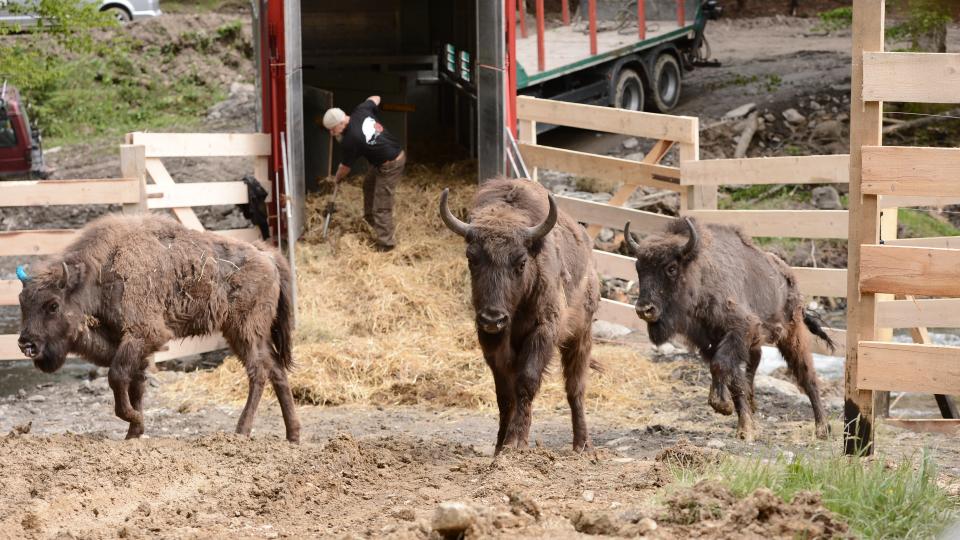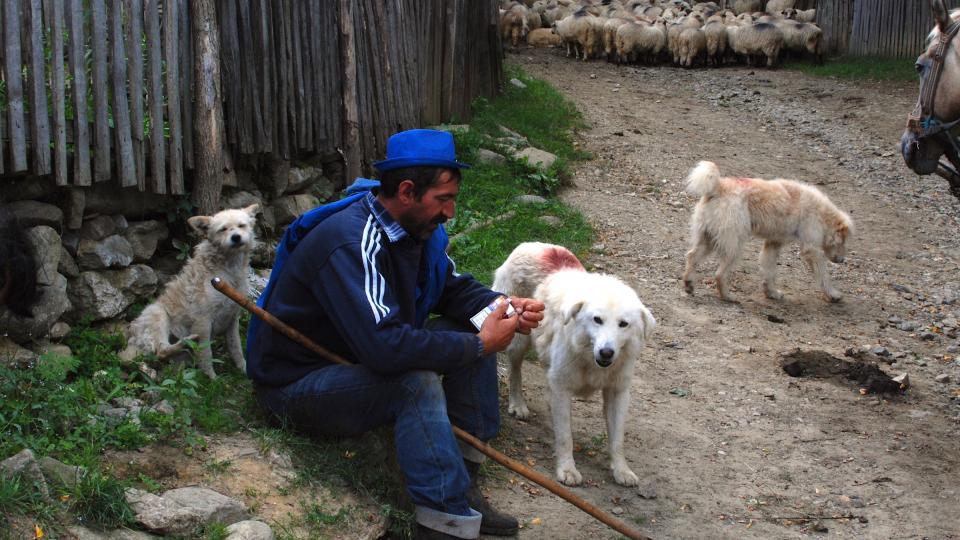Outside the enclosure, in a ravine, the carcass of a male bison was found in an non-physiological position, with its legs up and a horn locked in a tree root, most probably because after falling the bison tried to roll over and his horn got stuck.
This is a fragment from a 2016 necropsy report, which examined the death of four bison reintroduced into the Western Carpathians as part of a larger rewilding program two years earlier. From the dog tracks observed around the carcass, the veterinary inferred that the bison was chased to exhaustion by feral dogs. In the end, the bison fell in the ravine and was killed and partly consumed by the dogs. We use this particular incident to scrutinize ideas about wilderness, the wild, and the feral in recent Romanian environmental narratives that have emerged around rewilding initiatives.

Release of the first bison brought a long way from zoos and reserves across Europe, into the rewilding enclosure. Southwestern Carpathians.
Release of the first bison brought a long way from zoos and reserves across Europe, into the rewilding enclosure. Southwestern Carpathians.
Photograph by Silviu Matei, www.outdoorphotography.ro.
© Silviua Matei. Used by permission.
The copyright holder reserves, or holds for their own use, all the rights provided by copyright law, such as distribution, performance, and creation of derivative works.
In May 2014, the largest ever European bison reintroduction started in the Carpathians, aiming to create free-roaming herds of 300 bison. The species had been extinct in the area for 250 years. This project was part of a more general move towards rewilding upland areas of Europe through experimental naturalistic grazing, an idea that is growing in popularity within European conservation. The dogs came into the rewilding project as a disturbance and raised heated debates. After the four deaths, environmentalists and forestry practitioners called for drastic measures against what now seemed to be the largest threat to wildlife in the Carpathians: feral dogs.
Debates over free-ranging dogs were not new in Romania. In the late 1990s, stray dogs became a major concern in urban areas. In Bucharest the stray dog population was estimated at 300,000 in 2001 and was responsible for 23,000 bites annually. The reason identified for the proliferation of stray dogs was the ramifications of the socialist urban development plan of the 1980s, when entire residential areas were demolished and people abandoned dogs as they were moved from houses into smaller flats. Twenty years later, the resulting stray dogs were culled as part of a “civilizing” process amidst the chaotic postsocialist transition. In recent years, feral dogs roaming the forests have become a major issue in the context of growing environmental concern. The culprits are holiday-house owners, and mountain shepherds, who abandon unwanted puppies. Currently, hunters are allowed by law to shoot dogs on hunting grounds when found further than 200 meters away from settlements and without human supervision or distinctive signs of being owned. In the city, they were a threat to civilization; in the forest, they are a threat to wilderness.
During our fieldwork research in the Carpathian Mountains, we heard stories of wild dogs chasing stags or fighting wolves; hunters killing dogs for sport and being criticized by other hunters for cruelty; foresters culling dogs in an attempt to protect wildlife. We did research in the bison rewilding area after the incident, and conducted interviews and an analysis of media coverage, expert reports, and online debates emerging around the bison deaths and a few other incidents involving feral dogs in forest areas. Our analysis reveals a ranking of wildlife, in which feral dogs are placed as degenerate outcasts, in sharp contrast with the noble bison. Drawing on these emic comparisons, we contend that contemporary narratives about feral dogs in Romania follow two major rationales.
First, feral dogs are seen through the lens of a domestic species. Their transgression is understood as decay. Abandoned by heartless masters, the loving, playful companions of humans develop atrocious behaviour; they become opportunistic and callous bandits. Neither wild nor domestic, feral dogs live on their own in the forest, but profit from human food scraps. They scavenge, spread disease, and harass and kill wildlife. Likewise, bison at the time of the rewilding incident were neither wild nor domestic. Released from an acclimatisation enclosure, and formerly captives in zoos, they were dependent on humans for food and safety. Both bison and feral dogs are what Haraway calls “natureculture”—beings that are inextricably a part of both human and nonhuman worlds. Yet, in the cultural imagination of Romanians, a firm boundary between domestic and wild seemed to exist. Dogs as a species are solidly domestic, whereas bison are inherently wild. Both the removal of the feral dogs and the rewilding of the bison are attempts to disentangle nature from culture in order to relocate species to their cultural slots.
Second, feral dogs are not seen as productive for forest environments. Instead, they loot and destroy ecosystems. They are not natural or niche predators, but prey on anything on offer; they are unfair competition for other wildlife. Moreover, they diminish the levels of biodiversity; they have been reported to be surplus killers—that is, they kill more than they can eat. Bison, on the other hand, are perceived as ecosystem engineers. Through grazing, trampling, and rooting they transform and regenerate the environment, and their poop provides nutrients to the soil. They engineer “novel nature.”

One of the first bison released in the rewilding program in Southwestern Carpathians, 2014.
One of the first bison released in the rewilding program in Southwestern Carpathians, 2014.
© 2014 Silviu Matei, www.outdoorphotography.ro.
This work is used by permission of the copyright holder.
To understand rewilding dynamics one must look at the cascading effects of more-than-human encounters. For Carpathian environmentalists and foresters alike, the interaction between feral dogs and wildlife unsettles particular images of wilderness. By going feral, dogs transgress cultural boundaries of the domestic world, and become natureculture, with no place in the ecosystem. Research, field observations, moral evaluations, and ideas about wilderness and naturalness all weave a thick thread of a convergent narratives surrounding feral dogs, which emphasizes their negative effect on the environment, transforms them in a menace to wildlife, and ultimately argues for their exclusion.
How to cite
Voicu, Stefan, and Monica Vasile. “Canine Menace: Feral Dogs, Bison, and Rewilding in the Carpathian Mountains.” Environment & Society Portal, Arcadia (Summer 2019), no. 17. Rachel Carson Center for Environment and Society. doi.org/10.5282/rcc/8702.
ISSN 2199-3408
Environment & Society Portal, Arcadia
 This work is licensed under a Creative Commons Attribution 4.0 International License.
This work is licensed under a Creative Commons Attribution 4.0 International License.
2019 Stefan Voicu and Monica Vasile
This refers only to the text and does not include any image rights.
Please click on an image to view its individual rights status.
- Bubandt, Nils, and Anna Tsing. 2018. “Feral Dynamics of Post-industrial Ruin: An Introduction.” Journal of Ethnobiology 38, no. 1 (2018): 1–7.
- Gompper, Matthew Edzart. Free-Ranging Dogs and Wildlife Conservation. First edition. Oxford: Oxford University Press, 2014.
- Haraway, Donna J. The Companion Species Manifesto: Dogs, People, and Significant Otherness. Vol. 1. Chicago: Prickly Paradigm Press, 2003.
- Helmer, W., D. Saavedra, M. Sylvén, and F. Schepers. “Rewilding Europe: A New Strategy for an Old Continent.” In Rewilding European Landscapes, edited by H. M. Pereira and L. M. Navarro), 171–90. Cham: Springer International Publishing, 2015.
- Jørgensen, Dolly. “Competing Ideas of ‘Natural’ in a Dam Removal Controversy.” Water Alternatives 10, no. 3 (2017): 840–52.
- Karamaniola, Lavrentia. “Bucharest Barks: Street Dogs, Urban Lifestyle Aspirations, and the Non-Civilized City.” PhD diss., University of Michigan, 2017.
- Vasile, Monica. “The Vulnerable Bison: Practices and Meanings of Rewilding in the Romanian Carpathians.” Conservation and Society 16, no. 3 (2018): 217–31.










